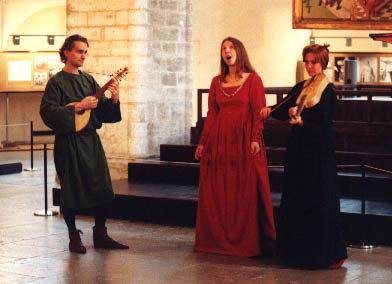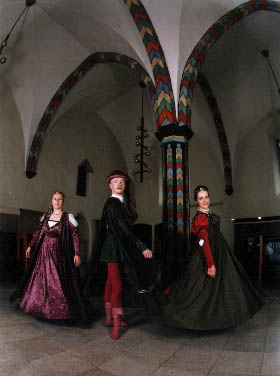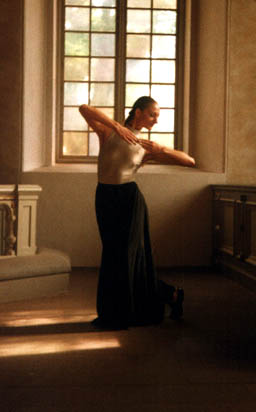|
PROGRAMMES
Rondellus' repertoire includes
both sacred and secular
music ranging from Gregorian chants to love and drinking songs and instrumental
dances, including music of the trouvères
and troubadours, works by Hildegard of Bingen, Guillaume Machaut, Francesco
Landini, Guillaume Du Fay, Gilles Binchois, Josquin Des Pres and others.
The number of musicians will vary from two (lute-song) to six (medieval
polyphony, renaissance consort music) depending on the type of programme.
These programmes are flexible and can be tailored according to specific
requirements. On the following pages are examples of some of them we
have recently performed and also programmes currently in developmental
stages.
|
SACRED
UP
 1.
CELESTIS SYMPHONIA - music by Abbess Hildegard of Bingen (1098-1179).
This was a special programme for 1998 as it was the 900th anniversary
of the birth of this most renowned historical figure, whose music
and writings have become extremely popular in recent decades.
As we consider Hildegard's music one of our specialities, we recommend
this programme for forthcoming years also. 1.
CELESTIS SYMPHONIA - music by Abbess Hildegard of Bingen (1098-1179).
This was a special programme for 1998 as it was the 900th anniversary
of the birth of this most renowned historical figure, whose music
and writings have become extremely popular in recent decades.
As we consider Hildegard's music one of our specialities, we recommend
this programme for forthcoming years also.
2. SALVE STELLA - sacred music from the Middle Ages associated
with/dedicated to Our Lady (Gregorian chant, Anonymous composers,
Hildegard von Bingen, Italian laude spirituali, etc.).
We have prepared this particular programme for several reasons.
First, we are from Estonia, a country that since the Middle Ages
has been called "Maarjamaa" - meaning Mary's Land (in
honour of Our Lady). Secondly, a large portion of the finest music
dedicated to the Virgin Mary has come to us from the Middle Ages.
We have taken our favourite selections and collected these into
a unique programme.
3. CARMINA SANCTORUM - sacred music from the Middle Ages
associated with/dedicated to medieval saints (Anonymous composers,
Hildegard von Bingen, music from Florence Manuscript, Codex Calixtinus,
etc.). A CD of this programme is available.
4. MUSIC FROM THE FLORENCE MANUSCRIPT (XIIIth c.) AND ITALIAN
LAUDE SPIRITUALE (XIIIth c.)
5. NOVA GAUDIA - A special programme for the Advent season.
Christmas songs of the Middle Ages from all over Europe: England,
France, Germany, Poland and Bohemia (from Florence Manuscript,
Bamberg Codex, Carmina Burana, etc.).
6. MYSTERIA DOLOROSA - MYSTERIA GLORIOSA - A special programme
of Medieval music for the Passion and Easter period (from Florence
Manuscript, Cracow Manuscript, Carmina Burana, Gregorian chant,
etc.).
|
|
SECULAR
UP
1. SABBATUM
- songs of the rock legend Black Sabbath arranged in the 14th
century style sung in Latin language. The CD Sabbatum (Beg The
Bug, 2002) has been extremely succesful all over the world.
2. LE VOIR DIT
(A True Story) - music by the greatest medieval French composer
and poet Guillaume de Machaut(1300?-1377)
3. FRENCH
MUSIC FROM THE XIV-XV C. - music by Guillaume de Machaut,
Guillaume Du Fay, Gilles Binchois and their contemporaries. This
programme could be enlarged to include XVIth century French music
also.
4. ECCO LA PRIMAVERA
- a lively programme of love songs, drinking songs and dances
from the XIIIth to XVIth century from Italy, France and England.
|
|
PROGRAMMES
WITH DANCERS UP
 1.
IL GRATIE D'AMORE - the programme consists of dances
and music from the XVth to XVIth century. 1.
IL GRATIE D'AMORE - the programme consists of dances
and music from the XVth to XVIth century.
As is now, dancing was a favourite entertainment in the Renaissance
period. The oldest descriptions of choreography in European
history derived from dance instructions found within manuscripts
originating from XVth century Burgundy and Italy (the Broussel
Manuscript, a manuscript by Michel Toulouse (1495) and manuscripts
by the Italians Guglielmo Ebreo and Domenico de Ferrara). During
the XVIth century in the upper classes, dancing became an elaborately
sophisticated art. It demanded years of practice by people of
fashion, who wanted to attain generally acceptable levels of
good manners and education, a component of which was dancing.
Thoinot Arbeau's "Orchesographie" (1589), Fabritio
Caroso's "Il Ballarino" (1581) and "Nobilta di
Dame" (1600) and Cesare Negri's "Il Gratie d'amore"
(1602) are the main sources of descriptions of XVIth century
dances. Common people had their own differences in dancing style,
which are no less interesting and vivid to observe and listen
to today.
The performance
of Saltatores Revalienses, an historic dance group from Tallinn,
provides an overview of the above mentioned periods and styles.
Dances are alternated with songs from the same period. These
are performed by Rondellus.

2. An experimental
programme in collaboration with dancers from a modern
dance studio - FINE 5, which brings together medieval sacred
music and modern choreography.
UP
|
|

